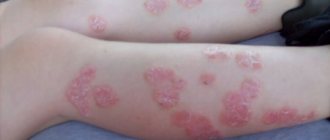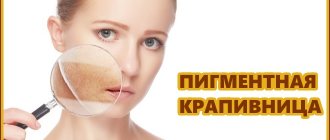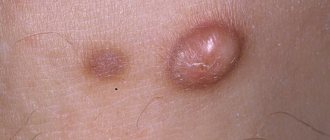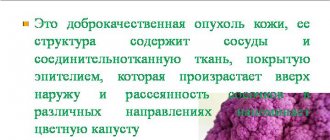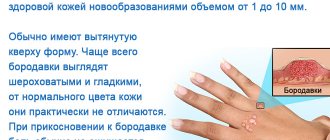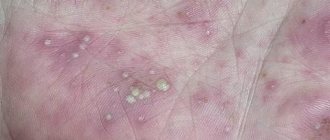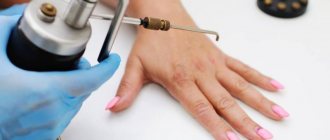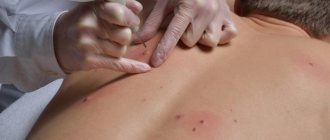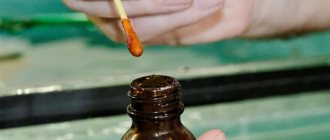A viral wart on the finger is a bump-like growth, the appearance of which is provoked by HPV. At first it is just a small papilla, which gradually grows until it reaches a size of 0.2-1.5 cm. Outwardly, it resembles a pigment spot, callus or some other skin defect. Such a formation rarely degenerates into malignant, but this possibility cannot be excluded. That is why you need to know what it looks like and what methods of removing it exist.
What does a viral wart on a finger look like?
Photo of viral warts on fingers
The appearance of a viral wart on a finger depends on its type. Thus, flat growths usually do not rise above the skin, but lie close to it. They are about 0.5 cm in size, round in shape, flesh-colored and relatively smooth in surface. In genital warts, the shade is closer to pink, the edges are uneven and there are rough spots on top.
Also on the finger, thread-like growths are quite common, which have a dense root that goes deep into the tissue. Their diameter reaches an average of 0.7 cm. They are connected to the skin by a thin stalk and protrude above the surface by about 5 mm.
Viral warts on the finger quickly spread over the skin and quickly reach large sizes due to the high activity of the pathogen. Due to their location between the fingers, they cause a certain feeling of discomfort.
With constant friction against tissue, there is a possibility of a violation of their integrity, which entails bleeding, irritation, itching, and redness. Scratching problem areas can lead to blood poisoning and inflammation of the skin.
Causes of viral warts
The causative agent of this infection belongs to human papillomaviruses, but only a small part of them leads to the appearance of round, flattened formations in the thickness of the epidermis - viral warts. Many types of papillomaviruses are generally harmless, others cause other types of skin reactions with the development of squamous cell papillomas and condylomatous growths. These structures are similar in many ways, but the mechanism of skin damage is different, which is why viral warts, papillomas and condylomas are distinguished as different nosological forms, each of which is characterized by its own type of pathogen.
Papillomaviruses are divided into episomal, which do not affect cellular chromosomes, and introsomal, which are integrated into the genome and can lead to tumor processes. Viral warts are caused only by episomal viruses, which indicates the benign nature of these formations. The viral affected area is stratified squamous epithelium. The pathogen penetrates to the basal layer, penetrates into cells, and upon microscopy is detected in the form of episomes - visually hollow formations with characteristic dust-like inclusions, most pronounced in the spinous layer of the epidermis. In damaged cells, dystrophic processes predominate, the stages of maturation are disrupted, and dyskeratosis develops. Normal epidermis has 5-6 layers, while viral warts are multi-row layers of enlarged cells with impaired exfoliation, due to which the affected area thickens and rises above the surface of the skin.
Since the virus penetrates only into the thickness of the epidermis and the basement membrane, but does not affect the underlying tissue, there is no inflammatory reaction, and productive and proliferative processes in the dermis also do not develop. Subsequently, viral warts become increasingly denser, this is due to pronounced keratosis with impaired cell desquamation; in many cases, after one and a half to two years, the skin formation is a completely keratinized nodule, which can fall off on its own with complete restoration of the epidermis.
Viral plantar warts develop somewhat differently. When walking, a small area of compacted and thickened skin constantly puts pressure on the underlying tissues, which causes fibrous fibers to grow in them, forming a kind of “thorn”, and the longer a viral wart on the foot is not treated, the wider and deeper the dermis is affected. At the same time, keratinization also intensifies; the person experiences pain, at first only when walking, and later even without putting any weight on the soles.
Warts of viral origin can have different sizes, but there is a pattern: the thicker the epidermis of the affected area, the larger the lesion will be. A viral wart on the foot usually has the largest diameter, where the skin is normally thicker; viral warts on the hands are somewhat smaller. Conversely, varieties such as viral flat warts develop in areas with a thin integumentary layer, therefore they usually occur at a young age and are also called juvenile, characterized by small sizes, slight elevation above the surface of the skin and unchanged color.
The cause of viral warts is the contact of the pathogen on damaged skin, and the wounds can be very small and invisible. Scratches, hangnails, and minor abrasions may well become entry points for the papillomavirus. The source of infection is squamous epithelium scales rejected from the affected skin; each of them can contain up to 200 viral replications. The virus, located in a dead cell, penetrates the skin of a healthy person, then the process depends on the state of the body’s immune defense. Viral warts may develop, a healthy carrier state may occur, or the virus will die without causing harm to the skin.
Multilayered squamous epithelial cells are found in abundance wherever people live; infected scales can also be found everywhere. The virus is able to survive for a long time in a dried state and retains pathogenic properties in the aquatic environment. You can become infected with viral warts through contact with the skin of a sick person, for example, by shaking hands. A common cause is infection in saunas and swimming pools.
Viral warts in children usually occur after swimming in ponds, playing on sandy beaches, where the child’s feet are not protected by shoes, and small skin lesions occur in abundance.
A viral wart on the finger is also typical for children, although it often occurs in people involved in cleaning premises and collecting garbage. The risk of infection is higher in people whose work involves multiple microtraumas - gardeners, field workers.
Causes of a viral wart on the finger
Regardless of how a viral wart on a finger looks in the photo, in any case it appears due to infection of the body with HPV. But this becomes possible only when its activity increases sharply, which can be caused primarily by disturbances in the functioning of the immune system. Such problems usually appear in the winter season, when vitamin deficiency is most often a concern.
The incubation period lasts about 3 months, although it can stretch for several years in the absence of problems with the immune system. Infection occurs during contact with HPV carriers, including through handshakes if the skin is damaged.
The pathogen enters the body through wounds along with lymph, blood, saliva, and lubricant. Therefore, it poses a danger when visiting doctors who do not particularly care about sterilizing instruments. Mostly, patients of dentists, cosmetologists, and gynecologists encounter viral warts on the finger for this reason.
Often, HPV transmission occurs when visiting public places, especially swimming pools, baths, and saunas. The reason for this is the high survival rate in wet conditions. The likelihood of infection remains when using any of the patient’s belongings, among which washcloths and other bath accessories pose a greater threat.
Despite the existence of numerous ways of transmitting HPV, the main route of entry into the body is through sexual intercourse. In this case, the pathogen enters during sexual contact, and this can happen even when using contraception. The likelihood of a viral wart appearing on a finger during the first sexual intercourse is especially high, since as a result of this, girls often develop blood, which serves as a conductor of infection.
Among other ways of spreading HPV, it is worth noting the likelihood of its transmission in the offices of manicure and pedicure specialists, as well as during tattooing. But this is only possible if they, like doctors, do not properly process the instruments.
People with the following problems are susceptible to the appearance of a viral wart on the finger:
- Violation of hygiene rules . This mainly applies to those who do not wash their hands with soap before eating and especially after visiting public places. They may also contain traces of the human papillomavirus, which, upon contact with the mouth, can enter the body.
- Treatment of various diseases . First of all, we are talking about gastritis and colitis, which themselves cause a deterioration in the microflora, and in combination with antibiotics almost completely destroy it. The danger of HPV activation also arises in the case of the development of tonsillitis, laryngitis, bronchitis, sore throat, etc.
- Bad habits . This refers to smoking tobacco and drinking alcohol. Firstly, they lead to intoxication of the body, and secondly, they worsen the microflora of the oral cavity. This increases the likelihood of developing otolaryngological diseases that negatively affect the immune system, which directly contributes to the appearance of a viral wart on the finger.
- Inactive lifestyle . This mainly applies to those who work at home remotely or in the office and are not involved in physical labor as such. Such passivity does not have a very good effect on health and reduces the degree of protection of the body, which is why it becomes unable, as it should be, to resist the human papillomavirus.
- Poor nutrition . This hides the lack of foods rich in nutrients in the diet - red fish, white lean meat, dairy, all kinds of fruits and vegetables, berries and herbs. A deficiency of apples, pears, peppers, onions, cabbage, rich in vitamins C and folic acid, iron and zinc, can be especially unpleasant.
- Hormonal disorders . This is most often talked about when mentioning women, since they are the ones who mainly suffer from such problems. They occur in most cases at the age of 45-50 years, but in rare cases they also occur in adolescents. The appearance of a viral wart on the finger is caused by a deficiency or excess of thyroid and adrenal hormones.
Why do warts occur?
The reasons for the appearance of viral warts are closely related to their name, and they are caused by a virus. What virus causes warts? This is only one pathogen - the human papillomavirus, which causes many diseases. This virus can be found in children and adults of any age. Most people are carriers of the papilloma virus, but in only a few it manifests itself as a skin disease. Once in the human body, the virus bides its time for a long time. But reduced immunity, an infectious disease, climate change, stress - all this can become the impetus for the onset of the infectious process.
During the activation of the virus, active damage to the stratified squamous epithelium begins.
The affected area of skin appears as a slight elevation without discoloration or active inflammation, since the lower layers of the skin are not affected.
If there is constant pressure on the wart (viral wart on the foot), then the affected area is depressed and fibrous fibers grow. Such warts are also called thorns.
The longer the virus is active in the body, the higher the likelihood of not only an increase in the number of warts, but also the occurrence of other infectious diseases.
Methods for treating viral warts on the finger
There are two ways out of the situation - use folk or medical remedies. For those who want to recover quickly, these methods can be combined. On average, therapy should last from 1 to 4 weeks, depending on the drugs. If the lesion is serious, you may need to take tablets, drops or powders with an antiviral and immunostimulating effect.
Folk remedies for viral warts on the finger
The most popular treatment for a viral wart on a finger is a solution of water previously brought to a boil (10 l) and purified sea salt (2 tbsp). The components need to be mixed and wait for the last substance to dissolve. Then the problematic finger should be kept in the composition for about 20 minutes. It is recommended to perform such manipulations once a day. On average, treatment lasts 2 weeks.
What is this?
Photos of viral warts
Viral warts in children and adults are called this because they are of viral origin. They are dangerous because they are contagious, that is, they are transmitted from one person to another.
Viral warts are caused by HPV, which is the human papillomavirus. The growths have characteristic external signs, which allows them to be quickly identified and distinguished from other skin diseases.
The HPV virus that causes the growths can affect children, teenagers and adults. At the same time, a viral wart on a finger, leg, and sometimes even on intimate places varies in shape, size and color.
This diversity is explained by the fact that HPV has many subspecies. Each of these subtypes of the virus provokes the appearance of one or another type of wart in a child or adult.
Varieties
Photo of viral warts
Next, you should find out what a viral wart is and what allows you to identify this or that type of growth.
- Ordinary. It is a dense small growth of a round shape with a rough surface. It usually appears on the hands, and in more rare cases on the head.
- Plantar. A wart on the heel may initially resemble a callus. The problem is that this type of growth often begins to be rubbed and steamed, as when removing calluses. This causes new warts to spread throughout the leg. Plantar types of growths are accompanied by painful sensations. Unlike other varieties, they grow inward rather than outward.
- Flat. She's a youthful wart. The name is due to the fact that the growth mainly affects young people. After 40 years, this type of neoplasm is extremely rare. The size is small, the surface is compacted, and the color is flesh-colored. They look like plaques. Usually located on the neck, chest, face, crooks of the arms and hands.
- Anogenital. More often you can find the name venereal or condyloma. The peculiarity is that it is sexually transmitted and manifests itself on the relevant organs.
- Prianal. Relevant for those who practice non-traditional sexual relations or sexual intercourse in openings not intended for this purpose.
Who is susceptible to HPV
Photo of what viral warts look like
In fact, HPV can “sit” in your body, but it does not manifest itself externally. Since we are talking about the fact that a wart is caused by a virus, why do some suffer from them, while others do not?
The point is that the mere fact of the presence of the human papillomavirus in the body does not mean that growths will necessarily appear after infection. The virus remains in the waiting stage for a long time—the incubation period. Its duration directly depends on the state of the immune system. As soon as the body gives up, there is a risk of warts appearing. They should be treated, not ignored.
Among the most susceptible to the appearance of warts, several groups can be distinguished:
- Overweight people;
- Suffering from chronic illnesses;
- People with gastrointestinal problems;
- Diabetics;
- Teenagers during puberty;
- Pregnant;
- Old men.
After looking at the warts photo, you will not want to encounter such phenomena. Therefore, the primary task is to contact a dermatologist. After determining the type and characteristics of your warts, your doctor will prescribe the appropriate treatment for viral warts.
For viral warts, treatment must be professional. If you are going to solve the problem at home on your own, be sure to consult with your doctor regarding the treatment methods used.
There is a category of people who prefer to treat everything with their own hands, without asking a doctor for advice. A very common practice is to remove the wart by pulling it with a thread. This is a potentially dangerous method, since after removal the minimal threat is recurrence of the growth. In the worst case, you will provoke the development of neoplasms, lead to the appearance of a huge number of new growths, or even turn a benign wart into a malignant growth.
Cause of warts
Why warts appear on fingers has been known for a long time. The reason is the genus of papillomaviruses, which includes more than 200 types of human and animal viruses. The human papillomavirus (HPV) has several dozen species. Papillomaviruses have tissue specificity: certain types infect a specific, characteristic place on human skin: hands, feet, genitals, body. Transmission of HPV infection occurs:
- by contact directly from person to person;
- indirectly - through household items;
- by dispersing the virus from the site of initial entry to other areas of the skin and mucous membranes.
It is easier for the virus to enter the body if the skin has microcracks, if it is softened by water (“bath” skin), or irritated. The state of the central nervous system plays a certain role in the development of infection.
The latent period after infection lasts from several months to several years. The degree of activity of the immune system, especially at the cellular level, is of great importance in the development of all types of warty growths.
Depending on what virus a person is infected with, warts appear on the fingers:
Even more interesting:
Sores around the head
Mouth ulcers hiv
- vulgar (ordinary, simple);
- flat (youth);
- epidermodysplasia verruciformis;
- butcher's warts.
The types of HPV that cause warts on the fingers are listed in Table 1.
| Clinical forms | HPV types |
| Vulgar warts | 1, 2, 3, 4, 7, 26, 27, 29, 41, 48, 57, 60, 63, 65,75, 78 |
| Flat warts | 3, 10, 28, 49 |
| Warts in epidermodysplasia verruciformis | 5, 8, 9, 10, 12, 14, 15, 17, 19, 220, 21, 22, 23, 2425, 36, 39, 40, 47 |
| Butcher's warts | 7 |
Prevention consists of following recommendations for personal hygiene.
What is human papillomavirus?
Human papillomavirus is one of the most common infectious diseases that occur in humans. In terms of the number of people affected, it is second only to cold viruses.
The virus enters the skin and mucous membranes through damage, even the smallest, especially on the hands, but does not enter the blood. Warts or papillomas are the only symptom of this disease.
There are about 120 varieties of the virus, all of them manifest themselves differently: the location on the body and the appearance of the formations differ.
Photo:
For example, plantar warts, which occur only on the foot and toes, are caused by only five types of HPV: 1, 2, 4, 27 and 57.
Anogenital warts or genital warts are caused only by virus types 6, 11, 13, 16 and 18. The surface of these formations is similar to a head of cauliflower.
Such a wart cannot be found on the hands or feet, since they are not found anywhere else except the anus and genitals.
In 1999, the human papillomavirus shook the whole world. A certain Dr. Wolbumers studied about a thousand women with cervical cancer and found that almost all of them (99.8%) were infected with HPV.
A little later, a connection was discovered between other types of cancer and papillomatosis.
The planet was gripped by mass psychosis - people, having learned about their HPV infection, already considered themselves terminally ill.
Subsequent studies in this area found that the percentage of people with cancer and HPV in the same vial was slightly lower than according to Wolbumers.
It also turned out that of the almost 130 types of the virus, not all are cancer-hazardous. Moreover, the types of virus that are associated with oncology have different strains, of which only a small part is capable of causing malignant processes.
However, the echoes of the panic that arose at the turn of the millennium are still noticeable. Despite the fact that treatment for HPV has not yet been invented, doctors are drawing up entire schemes to overcome the virus in order to prevent cancer.
Photo:
When a terrible diagnosis looms on the horizon, and the doctor operates in terms of “the second most common type of cancer in women,” you involuntarily want to give away your last money just to increase your chances of survival.
At the same time, doctors do not always tell that treatment with antiviral and immunomodulatory drugs, cauterization and surgical removal of warts does not guarantee a cure and can lead to the opposite consequences.
The best way to overcome fear and choose the necessary treatment is to understand what viral warts are.
Vulgar warts
Vulgar (ordinary) warts grow at any age, but more often in children and young people. They look like rounded, sharply defined dense nodular elements rising above the surface of the skin. They have no signs of inflammation, the size ranges from 1 to 10 mm in diameter. The nodule that appears first is larger and can be the size of a pea. Around the main “mother” wart, daughter elements appear.
Common warts are grayish-yellow, yellowish-brown, or normal skin color. Their surface is uneven, rough, covered with horny scales. The skin pattern at the sites where the growth occurs is not determined. When examined under a magnifying glass, dark dots are revealed (a sign of thrombosis of the capillaries of the papillae) - a diagnostic symptom of warts of this type.
Vulgar warts appear on the hands, often on the fingers, around and under the nails, on the back of the feet, rarely on the face: on the red border of the lips, the mucous membrane of the oral cavity. They are a cosmetic concern. When injured, they become painful and bleed.
Why should you see a doctor?
Some people think that there are no special problems and do not see a doctor for a long time. The longer the process is delayed, the more difficult it is to treat a wart. And it doesn’t matter what worries you, a simple wart on your arm or a papilloma in the genital area.
In both cases, a visit to the doctor should not be postponed also for the reason that any benign tumor can, after some time, degenerate into a malignant one. Also, a specialist who treats warts will suggest methods of elimination. He will explain the difference from papillomas and what they have in common.
Flat warts
Flat warts are also called juvenile warts, since this disease is typical for children, adolescents, and young women. Localized on the fingers, back of the hands, face, neck, chest, forearm, knee and wrist joints. They occur noticeably less frequently - in 4% of cases.
They look like flattened, rounded nodules that are yellowish-brown or the color of normal skin. Flat warts are small, they rise slightly above the skin level.
Unlike ordinary warts, flat warts are more numerous and have a smooth surface. Often arranged linearly as a result of viral seeding during scratching.
Verruciform epidermodysplasia
Verruciform epidermodysplasia Lewandowski-Lutz (generalized warts) is a rare chronic disease that develops in childhood. The cause of the pathology is a congenital defect of the immune system, mainly a decrease in the number and suppression of the function of T-helper cells. The main function of these cells is to enhance the adaptive immune response.
Warts appear on the skin of the hands, forearms, and legs. Neoplasms have some features depending on where they are located:
- on the face and neck they are similar to flat warts;
- on the fingers they look like ordinary warts, but they tend to group, arrange themselves in stripes and merge into a large warty lesion;
- Flat, sharply defined plaques and lesions resembling lichen versicolor appear on the body.
The color of the formations varies from the color of normal skin to pinkish-red, pinkish-brown. The disease is also characterized by age spots. Warts in epidermodysplasia verruciformis are caused by different types of human papillomavirus, but mainly by viruses types 3, 5 and 8. Several types of virus are detected in one patient.
Unlike other types of warts, which disappear on their own over time, epidermodysplasia verruciformis has a chronic course. The pathology has a high risk of malignant degeneration, especially in lesions located in open areas of the body. The most oncogenic are HPV-5, HPV-8, HPV-14.
Treatment
Pharmacy drugs
When treating with pharmaceutical drugs, carefully read the instructions and follow them strictly. What do pharmacy chains offer today? There is a large selection - ointments, creams, gels, sprays, tablets, aerosols.
If tablets can never be confused with gel, then not everyone knows the difference between cream and ointment. In ointments and creams, the active substance is always the same, but the auxiliary component is different.
- Ointments.
If surgical intervention is not required, the doctor prescribes conservative treatment with ointments. The base of the ointment is oily - medical Vaseline, fat, lanolin.
Water is never added to ointments. When you apply ointment to the surface to be treated, due to its fat content and density, it creates a film under which the temperature rises.
This allows the ointments to penetrate deeply into the tissue and enter the bloodstream. The ointment has a healing effect on the entire body. By killing the virus from the inside, it also destroys its external manifestation. Among all the ointments for warts, Viferon can be distinguished, which helps to quickly eliminate the problem.
- Creams.
The base of the cream resembles an emulsion. It is lighter and not very greasy. Unlike ointment, it does not penetrate deep into the tissues, but exerts its effect on the upper layers.
The cream always contains water. Creams have a cooling effect and are quickly absorbed into the skin. The majority of creams have a cauterizing effect.
For the best effect, it is recommended to take warm baths before applying the cream. After application, cover the surface with a sterile bandage.
- Pills.
Tablets for the treatment of HPV are divided into antiviral and immune-strengthening. These drugs are prescribed by a doctor. Sold in pharmacies with a prescription.
You must take the tablets according to the instructions. If necessary, the course is repeated.
The doctor almost always prescribes complex treatment. Therapy to strengthen the immune system, pharmaceutical and folk remedies to fight the virus, and drugs that directly affect the wart itself. Vitamin complexes are also very useful in this case.
Let's look at how to remove a wart at home using:
- freezing with nitrogen (Cryopharma, Wartner cryo);
- cauterization with such drugs as Supercelandine, lapis pencil, hydrogen peroxide;
- patches for skin growths – Salipod.
Clinical and hardware methods
When you contact the clinic, along with drug treatment, you will be offered other methods of combating this disease. For example, removal of viral warts.
- Surgical removal is advisable if other methods are not acceptable. It is performed using a special spoon (curette) or a scalpel. The procedure is painful and requires anesthesia. The healing process is longer than with other methods. Traces remain after surgery. You should not use this method on visible areas of the body, especially the face.
- Electrocoagulation method . Burning out a wart using electricity. Pain relief required.
- Laser is an affordable, painless method. Local anesthesia is required. Each papilloma is treated with a laser beam. Exposure time is no more than 1 minute. Scars may remain after the procedure.
- Treatment with liquid nitrogen at very low temperatures. New growths are practically frozen. After a while they fall off. Nitrogen overexposure leaves scars and other consequences.
Do you want to know which is better: laser or cryodestruction? Then read the pros and cons of each method here.
Only highly qualified specialists should provide such services. Improper handling of laser, liquid nitrogen or current can cause irreparable harm to health. You can see the consequences after removal here.
Electrocoagulation
Surgical removal
Cryodestruction
Laser removal
Treatment of warts
The main type of treatment for viral warts is destructive therapy - destruction of tissue structures. Getting rid of skin lesions on the hands is not so easy: viral particles disperse into neighboring tissues, and fresh growths appear. Therefore, the likelihood of a relapse after tissue restoration remains high: the effectiveness of the technique is 50–80%. Nevertheless, destruction is the main method of treatment. Warts on the fingers are treated using physical methods:
- surgical excision (cutting);
- laser therapy;
- diathermocoagulation;
- cryodestruction.
For external treatment, cauterizing and keratolytic (softening, dissolving and sloughing of the stratum corneum of the epidermis) agents are prescribed. Generalized warts are treated systemically: patients take prospidin, vinblastine. Warty skin lesions are removed surgically. Systemic interferon therapy and vitamin A group drugs are indicated as staged treatment. For growths, cryodestruction, electrocoagulation, ointments with cytostatics are used: Podophyllin, Condilin, colchamine ointment.
Types of neoplasms
If a wart appears on your finger, you should definitely show it to a doctor. This is done so as not to confuse a normal skin lesion caused by a virus with something more serious. In addition, there are several types of warts, differing from each other not only in appearance, but also in the way they spread:
- Simple warts. The formation, which in most cases appears on the hands, has a round shape and a dense structure with a rough surface.
- Flat papillomas. These growths have a smooth surface and are concentrated mainly on the back of the hands. They can be of different colors - flesh, pink or yellow.
- Vulgar warts. Formations up to 1 cm in diameter cover the skin of the hands and often form entire families. When the maternal growth is detected and eliminated (it is most often larger), the remaining warts disappear on their own.
- Senile warts. Despite their compacted structure, these neoplasms are usually attributed to skin pigmentation, which develops during age-related changes. Typically, such spots appear not only on the upper limbs, but also on the back, face and neck. However, they do not pose any danger and are removed only for aesthetic purposes.
How to cure warts on hands
A skin growth that resembles a nodule in appearance is a wart. There are two types of such neoplasms: ordinary ones, which are brown and pink in color, and flat small ones with a yellowish tint. Regardless of what type of growth appears on the body, it is necessary to get rid of it in any case. There are different ways to treat warts on the fingers:
- Surgical. Warts are removed using medical instruments.
- Physiotherapeutic. Includes several methods: laser removal, electrocoagulation, cryotherapy.
- Chemical. This includes treating the disease with pharmaceutical drugs.
- Immunotherapy. Compliance with the rules of a healthy lifestyle, hardening the body, using interferon, taking vitamins and rosehip tincture with honey.
- People's Various herbs and essences will help in the fight against viral infection.
Warts on hands - causes and treatment at home
vlad 10.20.2018 at 00:31
You yourself can easily, simply and guaranteed remove warts at home. Our ancestors perfected these methods a long time ago, which differ in different regions of our country only in the availability of suitable drugs.
As an example, I will give three simple recipes, each of which requires only one treatment session (regardless of the number of warts being removed) and contains remedies available to everyone. These recipes have been effectively used by me, my relatives and friends on myself and on children too. The result is 100% irreversible removal of warts.
—————————————————–
1) Potatoes baked in ash!
You bake a medium-sized potato in ash (you don’t need a large one, a medium one will bake faster), then wait for it to cool a little - let it be warm, as long as you don’t get burned, then break it in half (break it, but don’t cut it - you don’t need contact with metal), check that the potatoes are baked completely, and apply the middle of any, but only one half (!) potato to each of your warts. All! The treatment session is over. Take your time to wash the wart. Throw away the potatoes (both halves), you don’t need to eat them - don’t be greedy. Ancestors usually threw potatoes into a wet ditch so that they would rot faster. Your wart goes away quickly, unnoticed and painlessly - you just suddenly discover its absence on some lucky day within three weeks. There are no scars left, the skin is clean.
I think this is the best recipe for children. I met him when my father reduced a large and very painful plantar wart in a four-year-old boy in this way. That was happiness! And when I was convinced that the recipe worked, I also removed a small dry “evil” wart that had been bothering me for many years (on the eleventh day after the treatment session I discovered that the wart was gone, perhaps it had gone away earlier, I just forgot and stopped checking every day ). Slogan: “You won’t notice how it comes off!” And also – let’s teach children to trust traditional medicine!
————————————————-
One day at the beginning of winter, a large wart quickly grew on the side of my index finger. Very uncomfortable! There was already snow, and you couldn’t light a fire in the city! But a solution was found quickly - I found recipes 2 and 3 in the book “Folk Methods of Treatment”, “Legavr” Publishing House, 1993, p. 130, “A True Healer’s Remedy for Warts and Moles.” And similar recipes are somewhere else, I just don’t remember where now and I can’t clarify. So, if you don’t know how or you have nowhere to bake potatoes in ash, then here’s your second recipe:
2) Raw potatoes!
We do everything the way our ancestors did it. You cut a potato in half and immediately throw either half away anywhere. Then use the remaining half (cut side) to rub each of your warts as much as you want. You do this once. Wrap half of the potato used to rub the warts in a piece of paper or a rag and place it in a dry and warm place where it will dry quickly. All! The treatment session is over. Take your time to wash the wart. After a few days (2-3, well, no more than 4), your warts begin to “turn out” of the skin along with the roots. The holes from the warts bleed a little, and scars remain that will definitely resolve, but not quickly. A little painful. When the warts are gone, you can throw away the dried potato half. Slogan: “Down with warts!”
I used this recipe - I rubbed it, thought about it, and to be sure, I rubbed it again, after which I wrapped the half of the potato used for treatment in paper, and, since it was winter, I put it on the central heating radiator to dry, and completely forgot about it, throwing it away in the spring , when I was cleaning the dust from the battery and saw it. The wart “fell out” completely, by the roots, on the fourth day, the body rejected it as if it were a foreign body, leaving a hole like a large pea - smooth walls and a small bleeding wound inside. The scar disappeared after about a year.
—————————————————–
My relative asked me to tell her how to remove a wart, but she didn’t know how to bake potatoes in ashes, she was afraid of pain and blood, and it was late autumn, there was a lot of dry grass, so the third recipe suited her:
3) Dry blade of grass!
You take a dry blade of grass, which you carefully dig out of the ground along with the root, shake off the soil, cut the blade of grass diagonally at a distance of several centimeters (no more than 10 cm) from the root and throw away the top of the blade of grass. Then, with the sharp end of the remaining blade of grass with the root, you kind of “prick” (but not until it bleeds, of course, but simply imitating “pricking”) several times on your wart. To put it rudely, you gently poke her several times. All! The treatment session is over! The wart goes away quickly. The ancestors also buried the blade of grass used for treatment in the ground, root up, in a damp place - so that it would not accidentally germinate and rot quickly. If you do this, then your ancestors will probably like your behavior. Slogan: “The blade of grass has rotted - the wart has gone!”
My relative was satisfied with the result of the treatment, although I don’t know the details. She didn't tell me because the area had very delicate skin.
—————————————————-
There are many recipes, but I think these three are enough. My favorite is the first one - painless, without scars, imperceptible - like an unexpected gift.
Hello everyone, good health and no problems!
Surgical and physiotherapeutic treatment of warts on the fingers
Any growths are unpleasant to the touch, and the person who suffers from such formations experiences discomfort. To get rid of an unpleasant disease, comprehensive treatment will be required. A viral nodule can be effectively removed by a surgeon using local anesthesia and a scalpel. The doctor completely cuts off the tissue of the growth and applies cosmetic stitches. Surgical excision of warts is performed if the growths affect a large part of the skin. Today this method has lost its popularity. It has been replaced by modern physiotherapeutic methods:
- Laser removal. Painless, fast, but at the same time expensive. After the procedure, there are no scars left and recovery occurs quickly.
- Electrocoagulation. Bloodless but painful method. After the wound heals, scars sometimes remain.
- Cryotherapy (use of liquid nitrogen). Also a painful procedure. Sometimes re-cauterization is required.
Methods for getting rid of warts
Since this disease is very common, quite a lot of methods have been invented to combat it. It must be remembered that the causes and treatment of warts are closely related, because if the causes are not eliminated, the treatment will be ineffective. In case of wart-type growths, it is necessary to consult a doctor as soon as possible, since treatment for warts should begin immediately after detection. Otherwise, the affected area will grow, and longer and more expensive treatment will be required.
The most popular methods for removing warts in medical institutions. They offer the following methods:
- Cryotherapy (growth cells are exposed to extremely low temperatures of liquid nitrogen, which promotes their death);
- Laser removal (neoplastic cells evaporate under the action of a laser);
- Electrocoagulation (growth tissue is cut off layer by layer using electric current);
- Surgical removal (excision of wart tissue under local anesthesia with the application of intradermal cosmetic sutures).
These methods are very effective (the recovery rate is from 50 to 94%), but they are quite expensive and have a lot of contraindications, as well as possible complications. For example, laser treatment sometimes leaves scars. Therefore, wart growths of the initial stage are treated in more gentle ways.
Chemical remedy for warts on hands
All medical chemicals should be used with caution, otherwise the procedure can cause burns. In order not to harm healthy skin, you should stick an adhesive plaster with a hole for the growth. Only the area of the wart needs to be treated with the substance. This method is not recommended for diabetics and people with circulatory problems. Among pharmaceutical alkaline and acidic drugs used to remove tumors, the most popular are:
- Solcoderm. The medicine contains 4 acids: lactic, acetic, nitric and oxalic. Has a cauterizing effect.
- Salicylic acid. It is inexpensive at the pharmacy and available without a prescription. The effect of treatment occurs within a few weeks.
- Super clean. This alkaline formulation, including potassium hydroxide and sodium, is contraindicated in children. Treatment lasts 5 days.
- Verrucacid. The drug contains metacresol, phenol. For small warts, apply once. Cannot be applied to a child.
- Vartek. At the pharmacy the medicine is sold in the form of a cream. It has a mummifying and cauterizing effect on the formation.
- Kolomak. A product that can melt tissue. The solution contains polidocanol, salicylic and lactic acids. The drug can be used to treat growths in young children.
Treatment options
There are two main ways to treat warts:
- Medication;
- Clinical.
Each of them has its own advantages and disadvantages.
- Drug treatment. Allows you to get rid of warts in a fairly short period of time. But depending on the drugs used, treatment may take more than one week or month. Medicines help suppress the virus and resolve growths. Most experts recommend using these methods. But it is important to use medications if the warts do not cause serious discomfort or are not accompanied by modifications that may threaten the development of an oncological form of the growth.
- Clinical. This treatment is not aimed at treatment, but at removing growths. Appropriate tools or apparatus are used. The advantage is that the wart is usually removed in one session. But after the procedures, scars may remain.
Dermatologists agree that clinical intervention is a last resort and should be used if other methods have failed.
The most gentle treatment option is to strengthen the immune system by taking immunostimulants, vitamins and doing various exercises or hardening.
Drug treatment
There are several types of medications that can help you get rid of growths by visiting a pharmacy after your doctor has issued an appropriate prescription.
- Ointment. It is best to start treatment with ointment. They are effective and allow you to penetrate deeply into the viral wart. Treatment of warts in children should be carried out with an ointment that does not contain too aggressive components.
- Cream. It only affects the top layer, so the cream is not suitable for all types of viral growths.
- Pills. Your doctor may prescribe pills to strengthen your immune system, antiviral medications, or both. You can only buy them with a prescription, so you can’t do it without visiting a doctor.
The best treatment is comprehensive. Therefore, when buying tablets, you should additionally treat the growths with ointment or cream. And vice versa.
Clinical treatment
If you cannot wait for the growth to heal, then you will have to resort to clinical methods. There are several main methods that are still relevant today.
- Excision. This is a surgical method. It is relevant only when no other approach can help, that is, in the most advanced cases. Involves cutting out the growth with a scalpel. Leaves scars. It is not recommended to use this method when removing growths on visible parts of the body.
- Electricity. The growth is burned out with an electric current. The doctor must first administer local anesthesia.
- A liquid nitrogen. The growth freezes and then falls off. A good method that is actively used in many medical institutions.
- Laser. The latest development in the fight against viral growths. A painless method that takes no more than 3 minutes.
The appearance of viral warts should not cause you to panic. Visit a dermatologist, draw the appropriate conclusions and start treatment.
